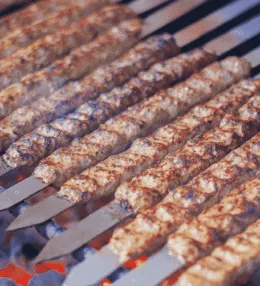
- View
Table of Contents
ToggleLardy Cake is a West Country treat with soft bread layers, sugar, and pork fat that bake into a glossy, sticky crumb. It looks humble yet eats like a celebration, rich and gently spiced, with pockets of fruit and a caramelised top that shatters under the knife. It carries a kitchen perfume that lingers long after the tin cools.
You pull apart flaky seams and find raisins glistening in syrupy sugar, while the dough stays pillowy and warm. It works as a teatime centrepiece, as a picnic slice, or with strong tea on a rainy day. A little goes far, so thin slices keep everyone happy.
Though the name sounds plain, the bake carries deep comfort. It grew from thrift and clever use of kitchen stores, yet today it feels indulgent and festive. Share it fresh, still slightly warm, and the table falls quiet as the spice and fruit drift across the room.
Want to dive deeper into British Cuisine? Don’t miss our post on Traditional British Foods to Try
What Is a Lardy Cake?
It is a yeasted bread made with layers of lard, sugar, and dried fruit folded through the dough. During baking, the fat renders and mingles with sugar, creating sticky caramel and tender sheets. The result sits between enriched bread and pastry, sweet and soft.
The method is simple in idea yet benefits from patience. The dough is rolled, dotted with lard and sugar, sprinkled with fruit, then folded and turned. That process repeats, building fragile seams that bake into ripples of sweetness and a shining, crackly crust. Resting the dough between turns helps keep those layers distinct.
Bakers vary the finish. Some dust with extra sugar before the oven for deeper gloss. Others brush a light syrup when it comes out to fix the shine. Cinnamon or mixed spice is welcome, and a pinch of salt keeps the sweetness in check and brightens the crumb.
Ingredients and Taste
A typical mix starts with strong white flour, yeast, warm milk or water, and a little sugar and salt. Lard is traditional and central to the texture. Soft light brown sugar brings gentle caramel, while dried fruit such as currants, sultanas, and raisins add chew.
Flavour lands in layers. First the crackle of the sugary top, then soft bread scented with spice, and finally bursts of fruit. The lard melts into the dough, giving it a tender bite and a savoury whisper that stops the sweetness running away. It feels balanced. A thread of citrus zest can brighten everything without stealing attention.
Variations exist. Some bakers add candied peel, others prefer apricots or mixed vine fruit. Butter is sometimes used, though the authentic character comes from lard. Serve warm, and the seams pull apart neatly, leaving sticky fingers and a lingering aroma.
A Taste of History
Lardy Cake belongs to Wiltshire and nearby counties where pig keeping and farm kitchens shaped village baking. On bake days, cooks used rendered fat left from curing and the last heat of big ovens to produce a rich loaf that would keep the family fed.
By the nineteenth century it appeared in printed recipes and market stalls across the West Country. Each town grew its own style, some thicker and heavily fruited, others lighter and spiced. The idea remained the same, thrift meeting pleasure in one tin.
Today you will still find it in local bakeries from Swindon to Bath, and on tables at fairs and harvest suppers. It carries place and memory, a slice that speaks of resourceful cooks and generous flavour. Take a bite and you understand why it endures. Bakers still debate sugar levels and spice blends, which keeps the tradition lively.
How to Make Lardy Cake (Fat Laced Sweet Bread)
Lardy cake is a rich, sweet bread from the south of England, best known for its soft layers of dough enriched with lard, sugar, and dried fruit. Expect a sticky, caramelised crust with a tender crumb inside. Patience is required for the dough to rise properly, but the results are deeply rewarding. See the recipe card at the bottom for printable directions
Ingredients
- 450 g strong white bread flour
- 50 g caster sugar
- 7 g dried yeast (fast action)
- 1 tsp fine sea salt
- 250 ml warm milk
- 75 g lard (for the dough)
- 125 g lard (for layering)
- 125 g soft brown sugar
- 150 g mixed dried fruit (currants, sultanas, raisins)
- 1 tsp ground cinnamon (optional but traditional in some regions)
Cooking Instructions
Step 1: Prepare the Dough
To begin, preheat your oven to 200°C (180°C fan) and lightly grease a square baking tin. In a large bowl, mix the flour, caster sugar, yeast, and salt. Gradually add the warm milk and 75 g of softened lard. Knead until the dough is smooth and elastic, around 10 minutes by hand or 6 minutes in a mixer. Leave to rise until doubled in size.
Step 2: Roll Out the Dough
Once risen, turn the dough onto a floured surface. Roll it into a large rectangle about 1 cm thick. This will be the base for layering in the lard, sugar, and fruit.
Step 3: Add the First Layer of Lard and Sugar
Spread one third of the remaining lard evenly over the dough. Sprinkle generously with one third of the brown sugar and a portion of the dried fruit. Fold the dough in thirds, like folding a letter, to encase the filling.
Step 4: Repeat the Layering
Roll the folded dough out again into a rectangle. Repeat the process with another third of lard, sugar, and fruit. Fold once more. This layering creates the rich, sticky pockets inside the cake.
Step 5: Final Layer and Fold
Roll out the dough for a final time, adding the last portion of lard, sugar, and fruit. Fold again and gently press to seal. Avoid overhandling as this can toughen the dough.
Step 6: Rest and Prove
Place the folded dough into the greased tin, pressing it to fit evenly. Cover loosely with a clean cloth and leave to rise until puffy, around 40 minutes.
Step 7: Bake the Lardy Cake
Transfer the tin to the preheated oven. Bake for 30 to 35 minutes until the top is golden brown and the sugar has caramelised. The aroma will be deeply sweet and spiced.
Step 8: Cool Slightly Before Serving
Allow the cake to cool in the tin for 10 minutes before turning out. Serve warm in thick slices, or let cool completely for a firmer texture.
Step 9: For Serving
Traditionally, lardy cake is enjoyed as it is, but it pairs beautifully with a cup of strong tea. Cut into squares or wedges, allowing the caramelised crust to shine.
Variations and Substitutions
- Lard Substitute: If lard is difficult to find, use unsalted butter or vegetable shortening, though the flavour will differ slightly.
- Fruit Options: Swap the dried fruit with candied peel or chopped dried apricots for a lighter variation.
- Spices: Add nutmeg or mixed spice alongside cinnamon for a more fragrant loaf.
Cooking Tips for Perfect Lardy Cake
- Use bread flour for a stronger structure that holds the layers.
- Ensure the lard is soft but not melted for even spreading.
- Resting time is key; do not rush the proving stages or the cake will be dense.
- For a stickier finish, brush the top with a little sugar syrup straight after baking.

Lardy Cake (Sweet Bread)
Ingredients
- 450 g strong white bread flour
- 50 g caster sugar
- 7 g dried yeast fast action
- 1 tsp fine sea salt
- 250 ml warm milk
- 75 g lard for the dough
- 125 g lard for layering
- 125 g soft brown sugar
- 150 g mixed dried fruit currants, sultanas, raisins
- 1 tsp ground cinnamon optional but traditional in some regions
Instructions
- To begin, preheat your oven to 200°C (180°C fan) and lightly grease a square baking tin. In a large bowl, mix the flour, caster sugar, yeast, and salt. Gradually add the warm milk and 75 g of softened lard. Knead until the dough is smooth and elastic, around 10 minutes by hand or 6 minutes in a mixer. Leave to rise until doubled in size.
- Once risen, turn the dough onto a floured surface. Roll it into a large rectangle about 1 cm thick. This will be the base for layering in the lard, sugar, and fruit.
- Spread one third of the remaining lard evenly over the dough. Sprinkle generously with one third of the brown sugar and a portion of the dried fruit. Fold the dough in thirds, like folding a letter, to encase the filling.
- Roll the folded dough out again into a rectangle. Repeat the process with another third of lard, sugar, and fruit. Fold once more. This layering creates the rich, sticky pockets inside the cake.
- Roll out the dough for a final time, adding the last portion of lard, sugar, and fruit. Fold again and gently press to seal. Avoid overhandling as this can toughen the dough.
- Place the folded dough into the greased tin, pressing it to fit evenly. Cover loosely with a clean cloth and leave to rise until puffy, around 40 minutes.
- Transfer the tin to the preheated oven. Bake for 30 to 35 minutes until the top is golden brown and the sugar has caramelised. The aroma will be deeply sweet and spiced.
- Allow the cake to cool in the tin for 10 minutes before turning out. Serve warm in thick slices, or let cool completely for a firmer texture.
- Traditionally, lardy cake is enjoyed as it is, but it pairs beautifully with a cup of strong tea. Cut into squares or wedges, allowing the caramelised crust to shine.
Nutrition
You May Also Like







Leave a Review